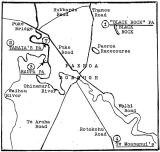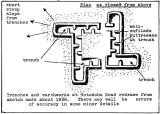Ohinemuri Regional History Journal 31, September 1987
By C W Malcolm
What could be more important, from the point of view of our local history, than a complete record of our earliest inhabitants? This article is certainly not that complete record, but it is an appeal to any who have the knowledge to supply the details before it is too late.
This outline and the questions it raises should provide a framework for the task. Keen as I was as a teacher to interest my pupils in their local history, I am only now, very late in life, adding fragmentally to my knowledge.
I assume that our early Maori inhabitants lived in four localities shown on the accompanying sketch map. Taraia's pa was first mentioned, I feel sure, in Journal No. 30 (1986) [see Journal 30: Puke Road's Most Historic Site - E]. Raupa pa in the hook of the uniting Waihou and Ohinemuri Rivers and its recent excavations have been dealt with in Journal No. 28 [see Journal 28: Raupa Pa - E] and in several other Journals.
But I have searched rather carefully to find anything on the other two sites, Te Moananui's pa and "Black Rock" pa, without success.
Trenches and earthworks at Rotokohu Road redrawn from sketch made about 1928. There may well be errors of accuracy in some minor details
In the 1930s I learned of interesting remains of Maori fortifications far out along Rotokohu Road at Te Moananui's Flat. What may still be there I do not know but I found a regular system of once well constructed trenches forming a "square" with projecting abutments at each corner and internal buttresses which could have provided defence against enfilading musket fire. Shown herewith is a copy of a diagram which I made at the time. Surely there must be some exciting history attached to this spot which I assume must be near the present Paeroa Golf Course.
What my pupils and I called "Black Rock" pa for want of knowing its proper name, is situated adjacent to that vertical rock feature that looks down on the road to Thames some distance past the Paeroa Racecourse. Though overgrown and eroded by time, the terraced construction of this very large pa was, in the days when we visited it, plainly visible. This may be seen in one of the photographs accompanying this article beyond the line of pupils assembled on a nearer terrace. But what was specifically noteworthy about this pa were the extremely large pits that had been dug on its surface. The photograph which illustrates the size of these pits shows the boys seated on the floor while the girls stand on the edge above.
The pit photographed was, from memory, some 20 feet long by 12 feet or more in width. We, of course, accepted them as the "food storage pits" used by the Maori, and being so large for the purpose of supplying the great population that must have occupied this extensive pa.
But there could be another explanation for the existence of the pits which Eldson [Elsdon – E] Best in his "The Maori as he Was"says were specifically used for the careful storing of the kumara. The Moriori, or Mouriuri as Best calls them, who preceded the Maori to these islands - though recently, in spite of claims by their descendants on the Chathams, the existence of such a race is being denied - were said to have lived in "pit dwellings" excavated from the ground and roofed over. I have read that the Moriori actually lived in our region. Were these unusually large excavations Maori kumara store pits or the dwellings of the Moriori? Unrecorded history grows dim and uncertain with the passing years, and speculation, though interesting, is not fact.
This article is an appeal for an intensive search to establish a factual record concerning Paeroa's first pre-European inhabitants who dwelt in these four locations surrounding the present town.




